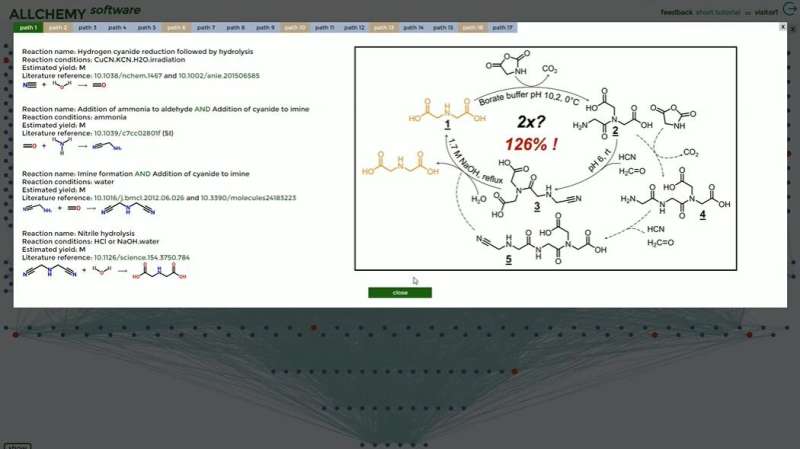A team of researchers working in the Institute of Organic Chemistry's lab at the Polish Academy of Sciences has developed a software product to aid in discovering the chemical processes that led to the development of life on Earth. In their paper published in the journal Science, the group describes their software program, which they have named Allchemy, and how it is used.
Scientists have been puzzling over the chemical processes that led to life on Earth for decades, but thus far, have not come much closer to understanding how simple chemicals in the primordial soup could have led to biologic molecules. Prior research has helped chemists identify some of the likely ingredients at play, such as methane, water and ammonia, and they have studied reactions between them that might produce precursors of molecules that could have interacted with other chemicals to produce living molecules. But the work grows challenging very quickly as chains of reactions are considered—so much so that humans cannot produce more than a few iterations. In this new effort, the team in Poland has automated the process by creating a computer program that accepts a list of chemical ingredients and then produces a network tree representing possible chains of reactions. The complexity depends on the number of starting ingredients and the number of iterations the computer runs. The program is limited only by processing power.
To test their program, the researchers used data describing nitrogen, ammonia, sulfur, cyanide, methane and water and ran the program for seven generations of chain reactions. After two hours of crunching, the program produced a complex tree representing possible reaction scenarios. Among them were 82 previously identified biotic molecules and 36,000 unidentified molecules. The researchers also noted that they found three patterns in the tree they generated. Molecules within the tree could behave as catalysts for other, later reactions, molecules could produce surfactants, and molecules could undergo self-replicating cycles.
The researchers have made Allchemy available for free with the hope that it will continue to evolve and reveal more about the chemical processes that led to life on Earth—and perhaps, on other planets.
Narrating construction of synthetic networks originating from basic prebiotic feedstocks. Screenshots of the Allchemy software show different synthetic generations within the network and discuss specific syntheses. Credit: Karol Molga, Agnieszka Wolos, Bartosz Grzybowski
More information: A. Wolos el al., "Synthetic connectivity, emergence, and self-regeneration in the network of prebiotic chemistry," Science (2020). science.sciencemag.org/cgi/doi … 1126/science.aaw1955
Journal information: Science
© 2020 Science X Network
























